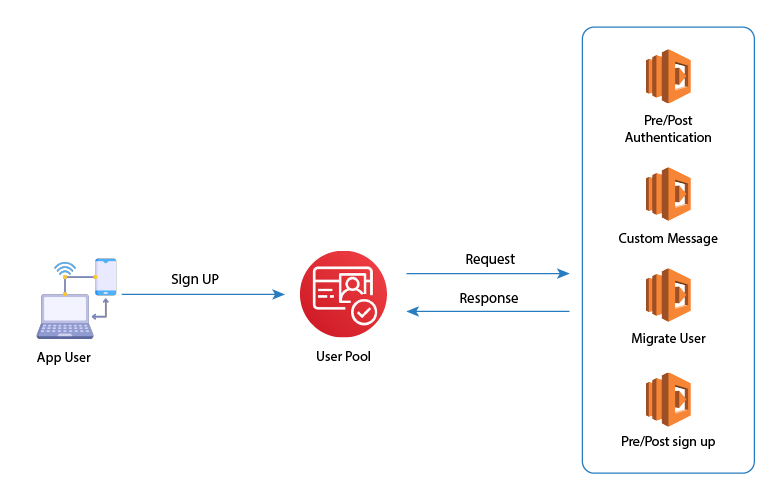Did you know that
“Serverless architecture market size exceeded USD 9 billion in 2022 and is estimated to grow at over 25% CAGR to from 2023 to 2032.” – Global Market Insights
AWS Lambda is among the widely used services for implementing the concept of serverless architecture. Provided by Amazon Web Services, AWS Lambda gives users a way to write, deploy, and run code in the AWS cloud that is reliable, scalable, and self-contained without requiring users to oversee the provision or management of any servers easily and efficiently.
While there are many similar services out there available to developers, none are as liberating as AWS Lambda. This service does not require to predict how many servers, CPUs, or how much memory the code will require to execute. Thus, with AWS Lambda, code runs in response to events and the compute resources needed to run the code are provisioned and scaled.
What is AWS Lambda?
AWS Lambda was first introduced in November of 2016. It was developed as a serverless computing platform for executing code, without the need to provision or manage servers. In order to develop the required logic for clusters that are aware of the workload, to maintain events, or to manage the runtimes.
AWS Lambda is very simple to use. Input the code, arrange it to be invoked by other AWS services, endpoints, or in-app events, upload the code as an upload in a zipped format or as a container image, and the service handles the rest. AWS Lambda provides sufficient processing power and runs the code in response to the invoked code or event. It can also be invoked by AWS Lambda, of which there are over 200 services and SaaS applications, or it can be called from a web or mobile app.
What is serverless computing?
It does not refer to what one would imagine it to be at first. Yes, there is a server involved, but it is not a server that the user or the admin must operate or run. However, serverless computing enables to develop and run applications and/or services without a requirement of the foundational hardware layer. All these responsibilities are automatically handled by the third-party host (in this case AWS Lambda).
Suggested: AWS Cloud Migration Guide: Explore the 7 Rs Strategy
5 AWS Lambda use cases
1. Using AWS Lambda to send mass emails with Simple Email Service
Communication, in the broadest sense of the term is an integral component of marketing services for every organization. Traditional solutions periodically demand a capital investment in such physical devises, expensive software licenses, and professional support.
This makes it wise to develop an in-house, cost-efficient serverless email solution with AWS Lambda and Simple Email Service (SES). In addition to S3 where the mailing list is to be stored, you can within minutes of preparation send out HTML or plain text emails to many people.

In this solution, any upload of a CSV file by a user leads to an S3 event. This automatically invokes another Lambda function that will parse the file and load it into the database in preparation to start sending an email to all the captured addresses.
2. Serverless IoT backend
Managing hundreds of IoT devices doesn’t sound easy. Additionally, addressing the data for more than one device at a time can be something of a hassle.

This is depicted in the diagram given above. Using AWS IoT, one can define rules to send device registration to the DynamoDB table using Lambda function. In addition to this, one can use an another Lambda function that looks for the serial number of a particular device from the database and a momentarily activation code generated for the device.
3. AWS Lambda position and utility in developing a serverless chatbot
Creating and executing chatbots involves a lot of time and money and not forgetting the demand for especially skilled workers. Some responsibilities include creating the environment in which the chatbot code will operate, managing the environment under which it will operate, and expanding the infrastructure that supports it. Although, by using AWS Lambda, you can implement a highly available and elastic chatbot architecture. Here’s how to get started:

- Enter your code logic to the Lambda function.
- Make the code reactive by linking it with what users send to the bot in terms of commands. They are API calls coming directly from the Slack Messaging, or other similar interfaces connected through API Gateway to the Lambda function.
- Lambda respires only when on command and therefore should be utilizing the resources when necessary.
Suggested: Why AWS is the right choice for your data and analytics needs?
4. Real-time notifications with AWS Lambda and SNS
Real-time notifications help keep everyone informed. This fact is crucial in DevOps because generally, they rely on constant communication. This ultimately leads to a faster and smoother DevOps workflow for ML models development using AWS Lambda.
When using SNS, one first creates a topic, which consists in defining policies for the determination of subscribers or publishers to be communicated within the topic. The published message of the SNS topic initiates the Lambda function to which it has subscribed.
Using the same, the function can process the information in the message and publish to other SNS topics, if needed, or send the message to other AWS services or end points.

For example: the infrastructural alerts in a Slack notification. Any time you have alarms in CloudWatch they will then send a message to that SNS topic. Gaining access to the message, SNS topic will trigger the Lambda function that will in turn send a message to the Slack channel through the Slack API.
5. Serverless authentication using Amazon Cognito
When used with AWS Lambda, Amazon Cognito can help add pre and post-login hooks on which it can invoked its own function.
Once the AWS Lambda function has been created, you are able to trigger it based on some specific user pool operations present like user sign up, user confirmation, login and other related operations and make it more complex, manually migrate the given users and send the personalized verification messages and a lot more.

The common triggering sources of the Lambda function include:
- Sign-up, confirmation and sign-in
- Pre and post authentication
- Custom authentication challenge
- Pre token generation
- Migrate user
- Custom message
The following are some basics of how custom message works. Invoking your Lambda function: Amazon Cognito will invoke the function for delivering the email or phone verification text or the multi-factor authentication code which will provide with the ability to customize messages as per the needs. The triggering sources for the custom message are:
- Confirmation code post-sign-up
- New accounts or users may be given a temporary password when making the accounts.
- Resending confirmation code
- Verification code for password reset DataService Response
- The following manual request refers to a new email/phone.
- Multi-factor authentication
Conclusion
Serverless computing has emerged as a game-changer in application development. Pioneered by AWS Lambda, it offers a paradigm shift, allowing businesses to shed the burden of server management and focus on what truly matters: their core functionalities. This translates into significant advantages – from seamless scalability and cost-efficiency to dramatically faster development cycles. However, the complexities of serverless architecture and its implementation can pose a challenge.
This is where Softweb Solutions comes in. With our expertise in AWS cloud consulting, Softweb Solutions can help businesses leverage the power of AWS Lambda to stay afloat and thrive in today’s competitive landscape. Our team of certified AWS professionals can provide a comprehensive range of services, including:
- AWS Lambda strategy and architecture design
- Lambda development and deployment
- Cost optimization
By partnering with Softweb Solutions, businesses can get the best of AWS Lambda and achieve the agility and cost savings necessary to stay afloat in today’s competitive market.









